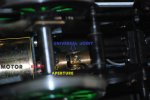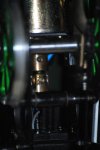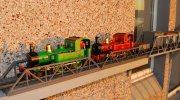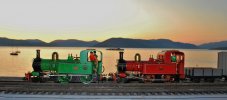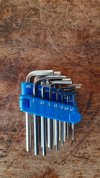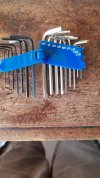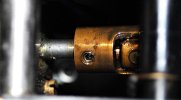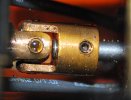Bolendo
Registered
Hi folks.
I recently was lucky enough to acquire two Accucraft 2-4-0 type IoM locos. They are robust wee machines, and finished to a very high standard. Most impressive.
However after running happily under test, the motor of one of them started revving without its power being transmitted to the driving wheels. I first assumed that it had stripped its gears. However on closer inspection, the motor drive shaft was found to be turning loosely inside the universal joint that is coupled to the gearbox. I noticed a small aperture in the universal joint casting, and thought that perhaps a grub screw had originally secured the mechanical connection, and had loosened and fallen out.
I used to work in public relations for one of the BR regions, so I am quite used to going down on my hands and knees - so I found myself looking everywhere for this missing grub screw, to no avail.
Then I checked the other loco. It didn't have a grub screw either. The small aperture in the brass casting was there, but its fitting around the drive shaft was tight.
At this stage, I don't particularly want to dismantle the loco, if a simple solution to the problem can be found. I have emailed Accucraft, but I believe they may be on holiday, as I have not heard back from them. They are usually pretty helpful.
I attach some photos. Has anyone had a similar problem?
I recently was lucky enough to acquire two Accucraft 2-4-0 type IoM locos. They are robust wee machines, and finished to a very high standard. Most impressive.
However after running happily under test, the motor of one of them started revving without its power being transmitted to the driving wheels. I first assumed that it had stripped its gears. However on closer inspection, the motor drive shaft was found to be turning loosely inside the universal joint that is coupled to the gearbox. I noticed a small aperture in the universal joint casting, and thought that perhaps a grub screw had originally secured the mechanical connection, and had loosened and fallen out.
I used to work in public relations for one of the BR regions, so I am quite used to going down on my hands and knees - so I found myself looking everywhere for this missing grub screw, to no avail.
Then I checked the other loco. It didn't have a grub screw either. The small aperture in the brass casting was there, but its fitting around the drive shaft was tight.
At this stage, I don't particularly want to dismantle the loco, if a simple solution to the problem can be found. I have emailed Accucraft, but I believe they may be on holiday, as I have not heard back from them. They are usually pretty helpful.
I attach some photos. Has anyone had a similar problem?

